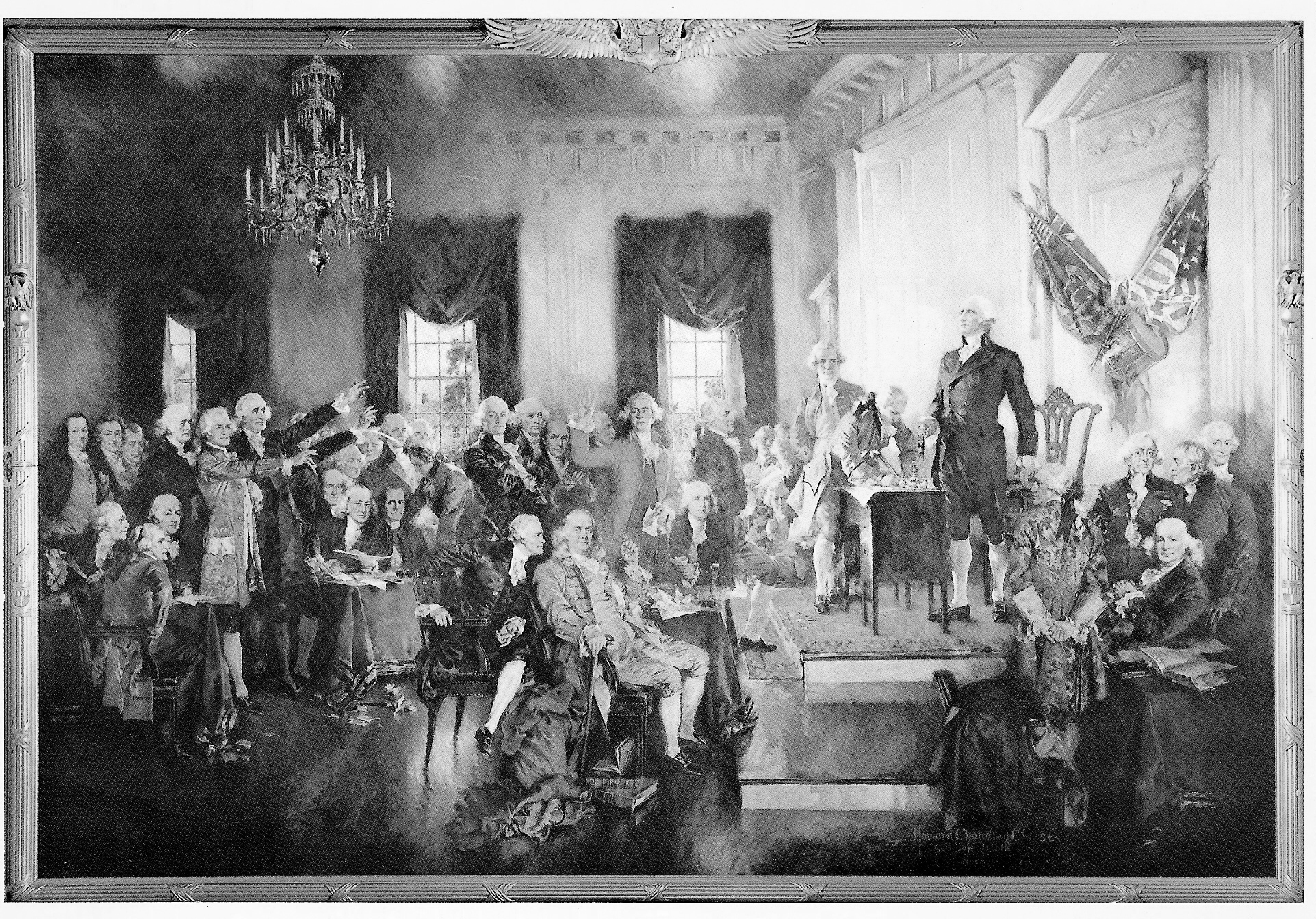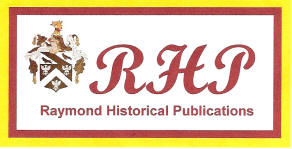|
Last time: Major conflicts in the American Revolution ended by late 1781 at Yorktown, VA, when Britain surrendered its main field army and a desire to rule the Colonies. By ‘85 the States were governing themselves but struggled to remain unified under the Articles of Confederation of 1777.
Chapter 14: The Constitution, The Lasting Law – 1786-1789 After years of faithful service, veterans of the War received little back pay as the new nation, largely severed from the English economy, wallowed in recession. By 1786 retired Continental officers, members of a fraternity honoring the Roman general Cincinnatus, were awarded land grants out on the Ohio River; the Cincinnati beat their swords into plowshares (Isaiah 2:4) and established a settlement there. The enlisted men could only return to their old farms and towns and struggled with low earnings despite hard work, yet were heavily taxed to help defray the war’s cost. A rebellion ensued in western Massachusetts in late ‘86, 100 miles or so from Cambridge, led by one Daniel Shays. Gentleman George Washington, Esq. was implored by Henry Lee, Continental cavalry officer (and father of Robert E. Lee), to intervene with his “influence”, to calm things down. Washington replied in a letter dated October 31, 1786, I am mortified beyond expression when I view the clouds that have spread over the brightest morn that ever dawned upon any country…. You talk, my good Sir, of employing influence to appease the present tumults in Massachusetts. I know not where that influence is to be found; and if attainable, that it would be proper remedy for the disorders. Influence is no government. Let us have one by which our lives, liberties and properties will be secured; or let us know the worst at once. Under these impressions…there is a call for decision. Know precisely what the insurgents aim at. If they have real grievances, redress them….If they have not, employ the force of government against them at once. If this is inadequate, all will be convinced that the superstructure is bad, or wants support. The insurrection was squelched early in 1787 by a local militia to defend the federal armory in Springfield, but only heightened the clamor for a new “superstructure” to respond with emphasis to such lawlessness, among other pressing needs. The Articles of Confederation were still operational and in July their most significant work was enacted. The Northwest Ordinance established six new Territories (OH, IN, IL, MI, WS, part of MN) and with certain triggers, including 60,000 residents and a constitution, would create future States with the same legal status as the original thirteen.
Shay’s Rebellion, however, helped trigger the Constitutional Convention in Philly (see the illustration by Howard Chandler Christy), and in May 1787 delegates elected Geo. Washington as President of the Convention. It was held behind closed doors and the daily minutes closely guarded. On September 17, 1787, 39 of 55 delegates from all 13 States approved the new U.S. Constitution. Inked on just a few pages of parchment, the nation’s highest law would provide for the common defense but also limit the federal government’s reach, declaring, “If it’s not in here, it’s up to the States.” A voice resonated not long ago from 200 years in the Framers’ future: I have read the constitutions of a number of countries—including the Soviet Union’s. Now some people are surprised to hear they have a constitution, and it even supposedly grants a number of freedoms to its people. Many countries have written into their constitution provisions for freedom of speech and freedom of assembly. If this is true, why is the Constitution of the United States so exceptional? The difference is so small that it almost escapes you, but it is so great it tells you the whole story in just three words: we the people. - Ronald Reagan, State of the Union Address, January 27, 1987
We the people, top of the heap, the government reports to us. Don’t like it? We do something about it every two, four, six years; and check it with an open press. President Reagan also spoke to American Exceptionalism in his SOTU. Yet just a quarter century later the 2012 edition distanced itself from exceptionalism, from individual uniqueness, displaced with the likes of “teamwork” and “spread the wealth”, ideas found nowhere in the Constitution. An ominous revisionism, no? In September 1787 the draft law still required the lengthy process of ratification by the States to mesh with their own charters. However, in this land of newly realized free speech, arguments for a more perfect union to replace the Articles hit the streets. In late ‘87 and into ’88, dozens of essays were printed in city papers including The (New York) Independent Journal and The New York Packet. Authored anonymously, they were collected as The Federalist Papers. The writers were unknown until well after the Constitution was law, in 1804 at the death of one by the dueling pistol of Aaron Burr (who’d age as a drunken social pariah.) Scholars now credit Alexander Hamilton with most of the essays, perhaps 51, and point to James Madison for 26, John Jay for five, with three a joint effort. One historian deems the work an "incomparable exposition of the Constitution, a classic in political science unsurpassed in both breadth and depth by the product of any later American writer." Thos. Jefferson was long considered “The Father of the Constitution” but today Madison receives as much credit despite shunning the honor during his days. Hamilton, by the way, would have made a fine chief exec but he was born offshore--no, not in Kenya—rather the Caribbean isle of Nevis. The Federalist serves as a tutorial for a law that’s endured largely unchanged for over 230 years, to the delight of “originalists”, the angst of “progressives.” Madison’s Federalist No. 10 discusses preventing majority rule by factions; it advocates an ever-expanding republic of private commercial enterprises; and is regarded philosophically as the most brilliant of the 85 articles. His Federalist 14 distinguishes an absolute democracy (workable only for a limited region and citizenry) from representative democracy, more practical for broader borders and a growing populace. The collected work details a bicameral legislature (the Congress), and balanced representation of small and large states (the Senate). In No. 51, Madison argues for checks and balances, an essay oft-quoted for its validation of government as "the greatest of all reflections on human nature." Some call it, not political science, but political art. Madison’s No. 39 defines the "Federalism" of a modern republic, noting that history provides few examples of a true republic, including ancient Rome; and that the proposed American republicanism is a radically new idea. He gives "Republic" three attributes: 1) power to govern is derived from the consent of the people; 2) representatives elected from the people are only the administrators of government; 3) terms of service are limited by time, good behavior, or as long as the “favor of the people” is maintained (politics, anyone?) In No. 68, Hamilton presents the first of 11 papers on a one-man executive, and No. 78 details judicial review by federal courts of federal legislation or executive acts. But the Federalist essays had their detractors in the Anti-Federalist, another 85 contentious papers that addressed “…the hideous daemon of Aristocracy ….” Valid food for thought, the decentralization thought of the day, but with little legs to trip up ratification. Yet they did set the stage for the two-party system that evolved in the late 1790s after three terms of Federalists. In June of 1788, NH was the ninth State to ratify the Constitution, giving America’s highest law the numbers to fly. During the signing procedure, in March 1788 here at home the NY State Township Act was authorized. The Town of Cambridge was born in Albany County, in future years heralded as “Old Cambridge District”. Finally, in July 1788, New York State ratified the U.S. Constitution and was admitted to the Union. Locally, construction of the Center White Creek Baptist Church was begun that year (completed in 1808). In February 1789 Citizen Washington was selected the first U.S. President in NYC when Congress counted the ballots of the Electoral College. On March 4 a brand new USA hung out its shingle for the first time as the Constitution became operational. (It wouldn’t be until 1791 that the Bill of Rights—the first ten amendments required by some States in the base document—was signed into law.) Washington was inaugurated April 30 with his first Veep John Adams, who had the second most electoral votes. His first Cabinet was State, Tom Jefferson; Treasury, Alex Hamilton; War, Hank Knox; A.G., Ed Randolph. That was it, just four. No Dept. of Butchers, Bakers, Candlestick Makers; no Horse-and-Buggy czars. Slim ops but enough to face down Europe and give private enterprise room to roam. Opportunity? Plenty. Nanny-state handouts? Not so much. In November 1789, Thanksgiving Day was proclaimed by President Washington (initially for this year alone): Whereas it is the duty of all Nations to acknowledge the providence of Almighty God to obey his will, to be grateful for his benefits, and humbly to implore his protection and favor…. A Founder once again conveyed God into the public square, yet by ’91 we’d have the 1st Amendment: Congress shall make no law respecting an establishment of religion, or prohibiting the free exercise thereof…. That’s it, no “separation of church and state”, no “wall”; but enough ink to put self-important ACLU lawyers, either ignorant or contemptuous of our historically deep religious culture, in pinstripes and Porches. While the writers of The Federalist wished to influence ratification of the Constitution and affect future interpretations, they had another purpose in mind, a challenge posed to the American people: It has been frequently remarked, that it seems to have been reserved to the people of this country, by their conduct and example, to decide the important question, whether societies of men are really capable or not, of establishing good government from reflection and choice, or whether they are forever destined to depend, for their political constitutions, on accident and force (Federalist 1.) Over two hundred years of “reflection and choice” give us the answer; “accident and force” have been trumped by the wisdom and virtue of this most timeless work of English literature and law. Through our Constitution, we’ve survived the darkest days of man: slavery and a civil conflict; two deathly world wars; a great depression; distant jungle and desert warfare; indeed, nuclear stare-down risking annihilation. We’ve not just survived, we’ve thrived. Ingenuity, sweat, and capitalism have elevated the standard for every American, and we’re a magnet to the world, drawn by the electricity of the “the Lasting Law.” Today we recognize September 17th as the birthday of our Constitution. In appreciation during Constitution Week, our youth are encouraged—by federal statute tied to public school funding—to compete in an oratorical contest sponsored by the American Legion (noted in The Eagle.) Citizens young and old are well served to review its four thousand plus words and, if you haven’t done so recently, see what the fuss is all about. Because in 2012 there’s at least one Constitutional issue poised to shape the nation for years to come. Seen as overreaching by the Feds, it’s about making you buy something you may not want or need, liberty vs. social responsibility, generosity vs. arm-twisting. Either we restore the Framers’ America in which “our lives, liberties and properties will be secured” (Geo. Washington), or hand their trust to today’s entitlement mongers as they pick our pockets, bust the treasury and shatter the Founders’ legacy. To be decided by the Supremes. Next time: Chapter 15, The American Presidency, Reporting to” We the People”, 1790-1800 Sources: A History of the Cambridge Area (R. Raymond, T. Raymond 2010); George Washington letters; The Federalist Papers; public domain. (Contact the author at tmraymond4@gmail.com. |
|
CAMBRIDGE HISTORY LIVES © 2011
|



